BBQ sauce isn’t just for weekend grills anymore. We’ve discovered that this smoky, tangy condiment can transform ordinary weeknight dinners into extraordinary flavor experiences. From glazed chicken thighs to barbecue-pulled pork pasta, the possibilities are endless when you start thinking beyond traditional grilling.
The secret lies in understanding how BBQ sauce works as a versatile cooking ingredient. Whether you’re braising meats, creating marinades, or adding depth to stir-fries, this beloved sauce brings that perfect balance of sweet, smoky, and savory notes that makes every bite memorable.
Ready to revolutionize your dinner routine? We’re sharing our favorite BBQ sauce dinner ideas that’ll have your family asking for seconds. These recipes prove that great barbecue flavor doesn’t require a backyard smoker – just creativity and the right techniques to maximize that signature taste we all crave.
BBQ Pulled Pork Sandwiches With Tangy Coleslaw
Transform your weeknight dinner routine with this crowd-pleasing sandwich that delivers authentic barbecue flavors using simple techniques. We’ll show you how to create restaurant-quality pulled pork sandwiches topped with refreshing coleslaw.
Slow Cooker Method for Tender Meat
Start with a 3-4 pound pork shoulder or Boston butt for optimal results. Season the meat generously with salt, pepper, paprika, and garlic powder before searing all sides in a hot skillet. Place the seared pork in your slow cooker and add 1 cup of your favorite BBQ sauce along with ½ cup apple cider vinegar.
Cook on low heat for 8 hours or high heat for 4-5 hours until the meat shreds easily with a fork. Remove the pork from the slow cooker and shred using two forks, discarding any excess fat. Mix the shredded meat with the cooking juices and additional BBQ sauce to taste.
Temperature control ensures perfectly tender results every time. We recommend checking that internal temperature reaches 195-205°F for maximum tenderness. Reserve some cooking liquid to keep the meat moist during serving.
Homemade vs Store-Bought BBQ Sauce Options
Create your own signature sauce by combining ketchup, brown sugar, apple cider vinegar, Worcestershire sauce, and smoked paprika. Homemade versions allow you to control sweetness levels and add unique flavors like bourbon or coffee. Simmer ingredients for 15 minutes to develop deep, complex flavors.
Premium store-bought options like Sweet Baby Ray’s, Stubb’s, or regional favorites save time while delivering consistent results. We prefer thicker sauces for pulled pork as they cling better to the meat and won’t make sandwiches soggy.
Experiment with different sauce styles to find your preference:
- Kansas City style: Sweet and molasses-based
- Carolina style: Vinegar-forward with tangy bite
- Texas style: Tomato-based with smoky heat
- Memphis style: Dry rub focused with minimal sauce
Perfect Bun Selection and Topping Ideas
Choose sturdy buns that won’t fall apart under the weight of juicy pulled pork. Brioche buns offer rich flavor and excellent structure, while pretzel buns add interesting texture contrast. Toast buns lightly on a griddle or in the oven to create a barrier against moisture.
Top your sandwiches with crisp coleslaw made from shredded cabbage, carrots, and a tangy dressing of mayonnaise, vinegar, and sugar. Add thinly sliced red onion, dill pickles, or jalapeños for extra flavor layers. We love including a slice of sharp cheddar or pepper jack cheese for added richness.
- Crispy fried onions with smoky bacon bits
- Grilled pineapple rings with fresh cilantro
- Avocado slices with lime crema
- Roasted corn salsa with chipotle peppers
BBQ Chicken Thighs With Grilled Vegetables
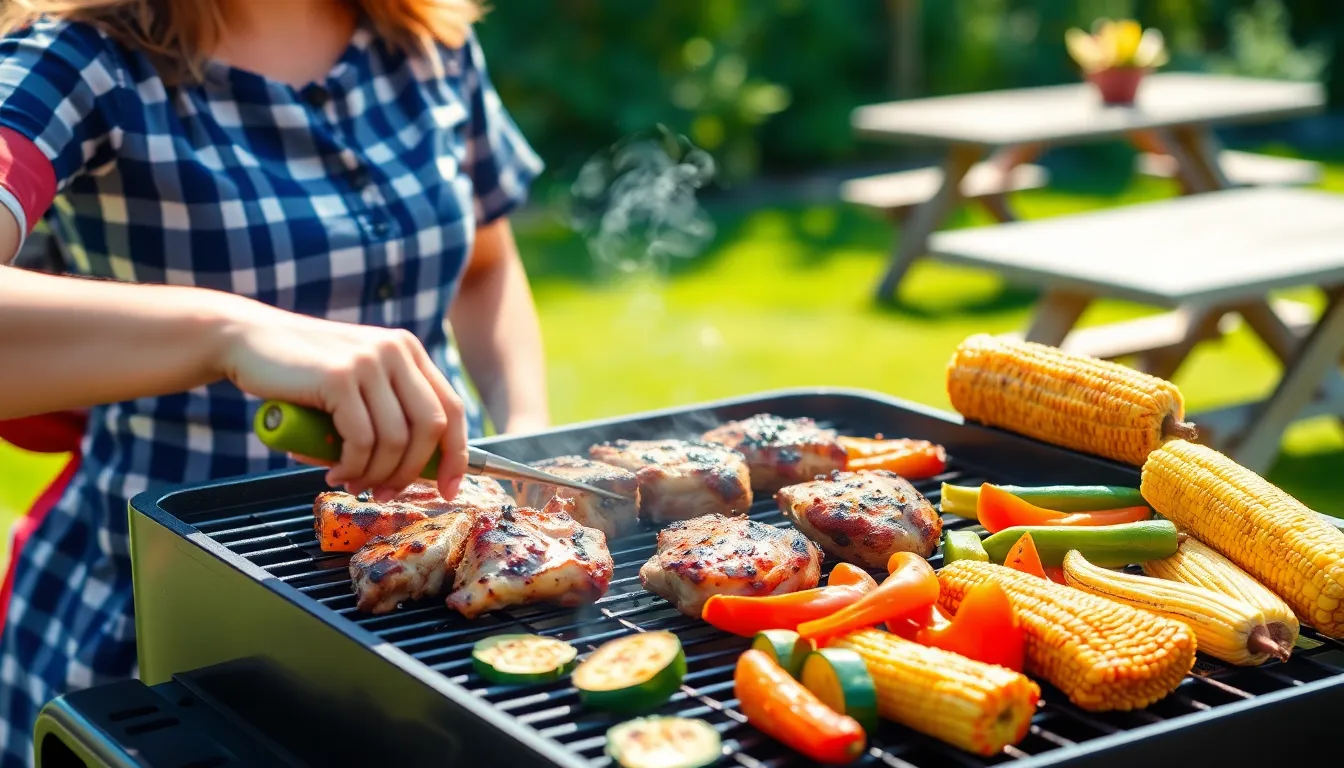
Chicken thighs deliver the perfect foundation for BBQ sauce dinner ideas with their naturally juicy texture and rich flavor. We’ll show you how to transform these affordable cuts into restaurant-quality meals that’ll have your family asking for seconds.
Marinade Techniques for Maximum Flavor
Marinate your chicken thighs for 1-2 hours minimum to allow the BBQ sauce flavors to penetrate deeply into the meat. We recommend using quality bottled BBQ sauce as your marinade base, which balances smokiness, tanginess, sweetness, and essential spices like paprika, cayenne, mustard, and cinnamon.
Add acidic ingredients such as vinegar or citrus juice to your marinade for extra tenderness. Apple cider vinegar works particularly well with BBQ flavors and helps break down tough fibers.
Baste the chicken during grilling to build layers of caramelized flavor on the surface. We apply BBQ sauce every 10-15 minutes during the cooking process, creating that signature sticky glaze everyone loves.
Reserve some marinade before adding raw chicken to use as a finishing sauce. This prevents cross-contamination while ensuring you have clean sauce for serving.
Best Vegetable Combinations for Grilling
Bell peppers provide sweet crunch and vibrant colors that complement BBQ chicken perfectly. We prefer red, yellow, and orange varieties for their natural sweetness when grilled.
Zucchini and yellow squash absorb smoky flavors beautifully while maintaining their tender texture. Cut them into thick rounds or lengthwise strips to prevent falling through grill grates.
Red onions caramelize wonderfully on the grill, developing sweet and savory notes that enhance BBQ sauce flavors. Slice them thick to maintain structure during cooking.
Asparagus spears cook quickly and add elegant presentation to your BBQ chicken dinner. We recommend choosing medium-thick spears that won’t overcook.
Corn on the cob brings natural sweetness and satisfying texture to round out the meal. Brush with BBQ sauce during the final minutes for extra flavor.
Mushrooms like portobello or cremini develop rich, meaty flavors when grilled. They absorb marinades well and provide umami depth to vegetable medleys.
Temperature Control for Juicy Results
Grill over medium heat at 350°F to 400°F to ensure even cooking without drying out the meat. This temperature range allows the chicken to cook through while developing proper caramelization.
Use indirect heat after searing to prevent burning the BBQ sauce sugars. We move chicken to cooler sections of the grill once initial browning occurs.
Monitor internal temperature with a meat thermometer, aiming for 165°F in the thickest part of the thigh. This ensures food safety while maintaining juiciness.
Rest the chicken for 5-10 minutes after grilling to allow juices to redistribute throughout the meat. This step prevents moisture loss when cutting and serving.
Create temperature zones on your grill by placing coals on one side for gas grills or adjusting burner settings. This gives you control over cooking speed and prevents flare-ups from BBQ sauce drippings.
BBQ Glazed Meatloaf With Sweet Potato Mash
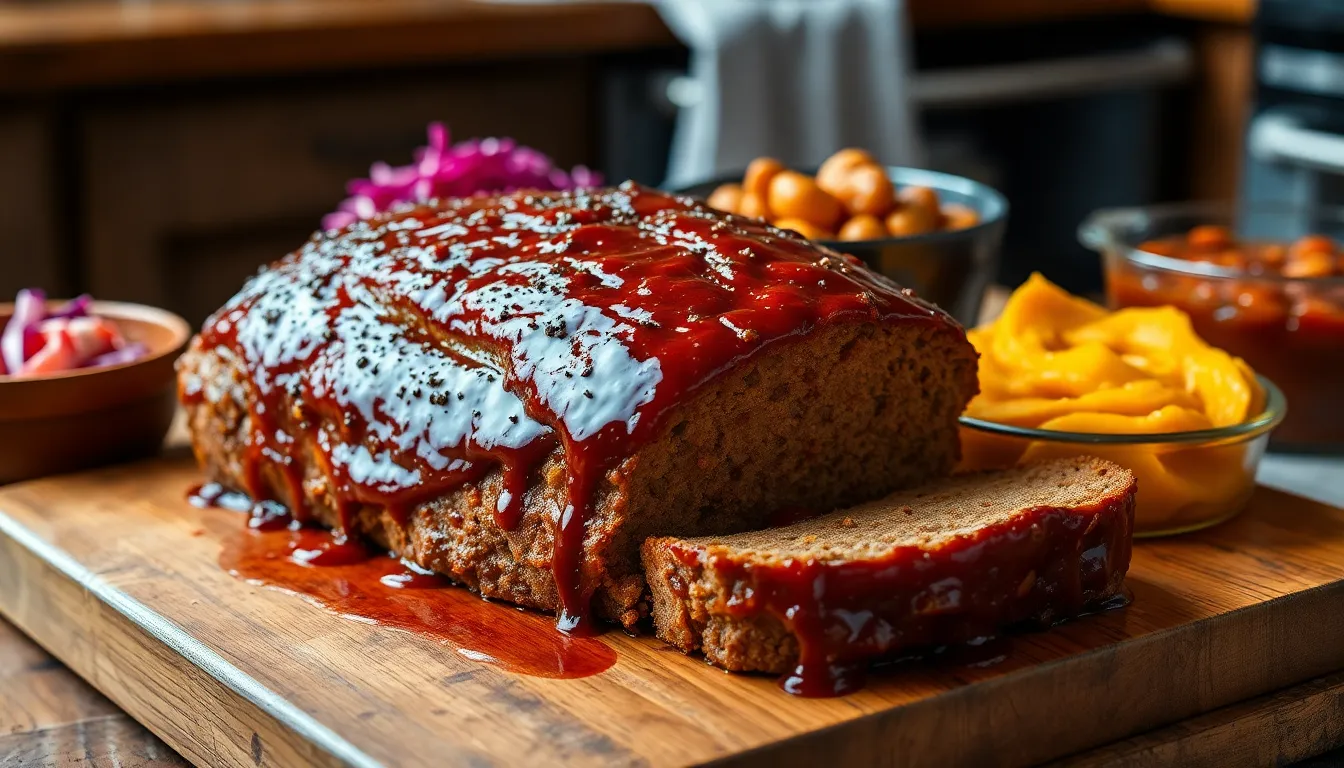
Elevating classic meatloaf with BBQ sauce creates a smoky, caramelized exterior that transforms this comfort food favorite. Sweet potato mash provides the perfect complement, offering natural sweetness that balances the tangy BBQ flavors.
Ground Meat Blending for Perfect Texture
Blending different ground meats creates the ideal meatloaf texture that’s both moist and firm. We recommend combining ground beef, pork, and veal for the best results. Pork adds essential juiciness to prevent dry meatloaf, while beef provides rich flavor depth. Veal contributes tenderness that makes each bite melt in your mouth.
Mixing technique matters just as much as meat selection. We avoid overmixing the meat blend to maintain a light, tender texture. Gentle folding with your hands works better than aggressive stirring, which can create a dense, tough meatloaf.
BBQ Glaze Application Timing
Timing your BBQ sauce application prevents burning while achieving that perfect caramelized coating. We apply the BBQ glaze during the last 10 to 15 minutes of baking time. Early application causes the sugars in BBQ sauce to burn and create bitter flavors.
This final glazing window allows the sauce to caramelize properly, forming a sticky, rich coating on the meatloaf exterior. We brush on a generous layer of BBQ sauce and return the meatloaf to the oven for that glossy finish. Multiple thin coats work better than one thick application for even coverage.
Side Dish Pairing Suggestions
Creating the perfect BBQ meatloaf dinner requires thoughtful side dish selection that complements the smoky flavors. We’ve identified several winning combinations that enhance this BBQ inspired meal:
| Side Dish | Flavor Profile | Why It Works |
|---|---|---|
| Creamy sweet potato mash | Natural sweetness | Balances tangy BBQ glaze |
| BBQ baked beans | Sweet and smoky | Reinforces BBQ theme |
| Red cabbage slaw | Crisp and refreshing | Cuts through rich meatloaf |
| Roasted vegetables | Earthy and caramelized | Adds texture variety |
| Cornbread | Sweet and crumbly | Soaks up extra sauce |
Sweet potato mash stands out as our top recommendation because it adds colorful contrast while improving the overall flavor profile. Preparing it with butter, cream, and light seasoning creates a smooth, creamy texture that pairs beautifully with the glazed meatloaf.
Coleslaw or red cabbage slaw provides a crisp, refreshing counterpoint to the rich, saucy meatloaf. We particularly enjoy how the acidity in slaw dressing brightens each bite. Roasted vegetables like zucchini, bell peppers, and carrots add both nutritional value and textural interest to the plate.
BBQ Ribs With Classic Southern Sides
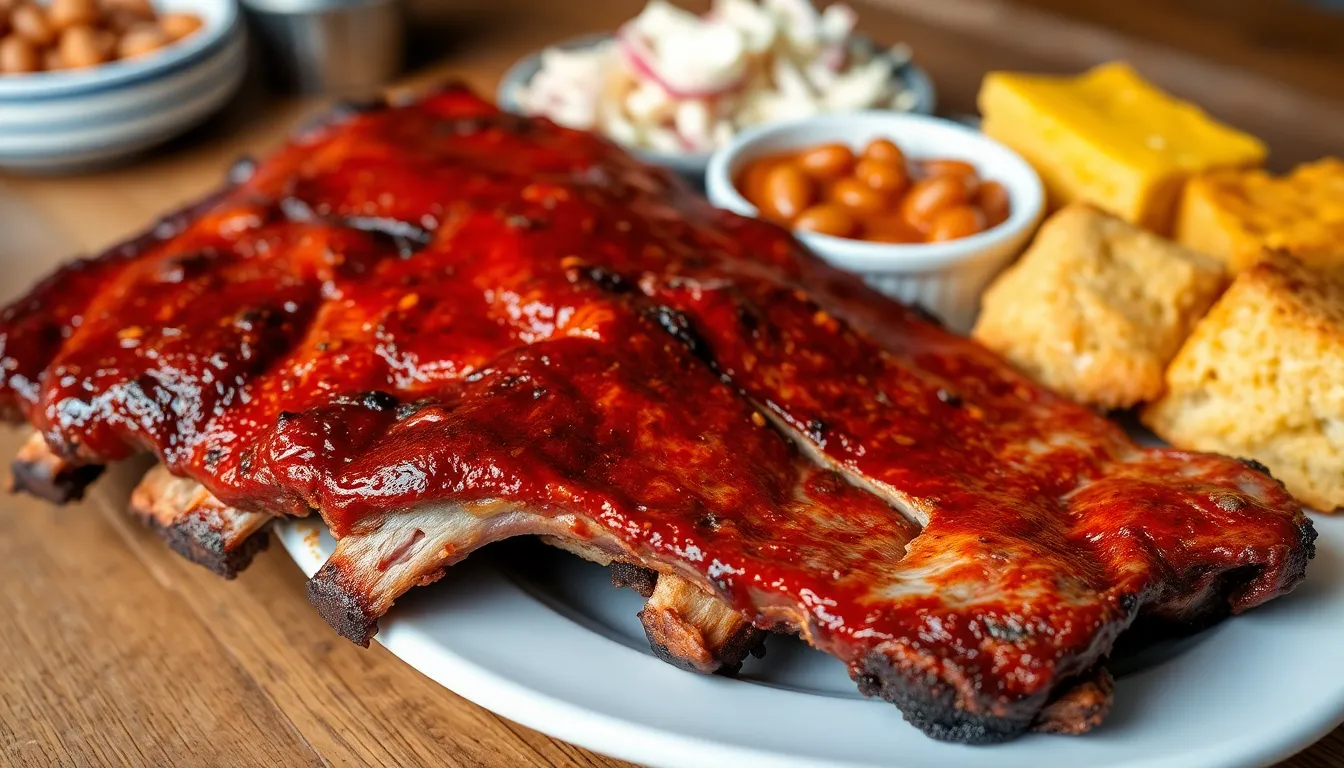
Nothing says comfort food quite like perfectly cooked BBQ ribs paired with traditional Southern sides. We’re diving into the art of creating tender, flavorful ribs that’ll have your dinner guests coming back for seconds.
Dry Rub vs Wet Sauce Preparation
Dry rubs create an intensely flavored, crispy bark on your ribs by combining spices like paprika, brown sugar, garlic powder, and cayenne pepper. We apply these spice blends directly to the meat before cooking, allowing them to season and seal in the meat’s natural juices. Dry rubs work especially well for skin-on chicken or ribs when you’re aiming for that coveted crispy exterior that BBQ enthusiasts love.
Wet rubs mix those same spices with liquid ingredients like apple cider vinegar, olive oil, mustard, or even bourbon to form a flavorful paste. We prefer wet rubs when we want to retain moisture and achieve a glossy, caramelized finish on our ribs. Wet preparations work particularly well for low and slow cooking methods because they allow the sugars to caramelize gently without burning.
You can actually use both techniques together for maximum flavor impact. We recommend drying the meat first, then applying your chosen rub to ensure the flavors absorb properly while improving the texture.
Low and Slow Cooking Techniques
Low and slow cooking transforms tough cuts of meat into tender, fall-off-the-bone masterpieces by breaking down connective tissues over extended cooking periods. We cook our ribs at temperatures between 225°F and 250°F for several hours, allowing the meat to develop that signature smoky flavor and crispy bark.
This technique works especially well with wet rubs because the moisture content and sugar caramelization contribute significantly to both texture and taste. We’ve found that maintaining consistent temperature throughout the cooking process is crucial for achieving that perfect balance of tender meat and flavorful crust.
Temperature control becomes your best friend during this process, as rushing the cooking time will result in tough, chewy ribs instead of the succulent meat you’re aiming for.
Traditional Accompaniments That Complement
Classic Southern sides create the perfect balance to rich, smoky ribs by adding contrasting textures and flavors to your meal.
Coleslaw provides a crunchy, tangy contrast that cuts through the richness of the meat with its crisp cabbage and acidic dressing. We love how the cool, refreshing crunch balances the warm, savory ribs.
Baked beans offer a sweet, smoky complement that echoes the BBQ flavors while adding hearty substance to your plate. These beans absorb the smoky essence and provide a satisfying, protein-rich side.
Cornbread adds a slightly sweet, soft texture that’s perfect for soaking up any extra BBQ sauce. We recommend serving it warm with butter for the ultimate comfort food experience.
Mac and cheese brings creamy, indulgent comfort food balance to your BBQ spread. The rich, cheesy pasta creates a satisfying contrast to the smoky meat flavors.
Pickles and onions add essential acidity and sharpness that help cut through the fat content of the ribs. These tangy additions cleanse the palate between bites and enhance the overall dining experience.
BBQ Shrimp Skewers With Pineapple

Shrimp skewers paired with pineapple create the perfect sweet and savory combination that transforms our regular BBQ sauce into something extraordinary. Threading shrimp and pineapple chunks onto skewers alternates textures while the tropical fruit adds natural acidity to balance the smoky flavors.
Seafood BBQ Sauce Variations
Traditional BBQ sauce gets a tropical makeover when we incorporate citrus and fruit elements specifically designed for seafood. Pineapple juice blended into our favorite BBQ sauce creates a fresh, fruity contrast that enhances shrimp without overpowering its delicate flavor. Lime juice adds bright acidity that cuts through rich, smoky notes while mango puree introduces tropical sweetness.
Mustard based BBQ sauces work exceptionally well with seafood since they provide tangy depth without the heaviness of tomato based varieties. We’ve found that sweeter BBQ sauce variations complement shrimp’s natural sweetness while spicier versions add complexity. Experimenting with different seafood exact BBQ sauces elevates our dinner from ordinary to restaurant quality.
Grilling Time for Perfect Doneness
Grilling shrimp skewers requires precise timing to achieve perfect doneness without rubbery texture. We cook our shrimp skewers for 2-3 minutes per side over medium high heat until they turn opaque and develop slight char marks. Overcooked shrimp become tough and chewy, so monitoring them closely prevents disappointment.
Pineapple chunks need brief grilling just to caramelize their natural sugars and soften slightly. We avoid cooking pineapple too long since it can disintegrate and lose its structural integrity on the skewer. The key is achieving that perfect balance where shrimp are fully cooked and pineapple is caramelized but still firm.
Tropical Side Dish Combinations
Coconut rice serves as our top recommendation for complementing BBQ shrimp skewers since its creamy texture and subtle sweetness enhance the tropical theme. Cilantro lime rice provides fresh, herbaceous notes that brighten the entire meal. Grilled corn on the cob with chili lime butter adds smoky sweetness that pairs beautifully with our BBQ seafood.
Fresh mango or pineapple salsa brings vibrant colors and refreshing acidity to balance rich BBQ flavors. Black bean and corn salad with bell peppers and avocado creates a hearty, nutritious side that complements shrimp’s protein content. Caribbean style coleslaw with shredded cabbage and tangy dressing provides the perfect crunchy contrast to tender shrimp and soft pineapple.
BBQ Bacon-Wrapped Chicken Breast

We’re stepping up the BBQ game with this show-stopping dish that combines the savory richness of chicken, smoky bacon, and that signature BBQ sauce glaze. This recipe delivers restaurant-quality flavors right from your kitchen while creating an impressive presentation for weeknight dinners or special occasions.
Stuffing Options for Extra Flavor
Cream cheese mixed with herbs and spices creates a rich, creamy center that complements the BBQ sauce beautifully. We love adding fresh chives, garlic powder, and a touch of paprika to create a savory filling that stays moist during cooking.
Chopped jalapeños and cheddar cheese bring heat and tang that pair perfectly with sweet BBQ sauce flavors. Dice the jalapeños finely to distribute the spice evenly, and use sharp cheddar for the best melting properties.
Spinach and feta cheese offer a Mediterranean twist that adds complexity to your BBQ creation. Sauté the spinach first to remove excess moisture, then crumble in quality feta for a creamy, tangy contrast to the smoky bacon.
Mushroom and garlic sauté provides earthy depth that enhances the overall flavor profile. Cook mushrooms like cremini or shiitake until golden, then add minced garlic for an aromatic stuffing that complements both bacon and BBQ sauce.
Bacon Selection and Wrapping Technique
Thick cut bacon holds its shape better during cooking and delivers superior texture compared to regular strips. We recommend choosing bacon that’s about 1/4 inch thick to ensure it crisps properly without overcooking the chicken.
Partially cooking the bacon first prevents the dreaded undercooked bacon scenario that can ruin this dish. Cook strips for 3-4 minutes until they’re just beginning to crisp but still pliable enough to wrap around the chicken.
Wrapping bacon strips tightly around stuffed chicken breasts requires a systematic approach for best results. Start at one end and spiral the bacon around the breast, overlapping each strip slightly to create complete coverage.
Securing with toothpicks or kitchen twine keeps everything in place during the cooking process. We prefer kitchen twine because it won’t burn and provides more reliable hold than toothpicks, which can sometimes shift during cooking.
Oven vs Grill Cooking Methods
Oven baking at 375°F for 25-30 minutes provides controlled, even heat that ensures thorough cooking without burning the bacon. This method works especially well for beginners because it’s more forgiving and allows you to monitor progress easily through the oven door.
Finishing with a broil gives you that perfect bacon crispiness if needed after the main cooking time. Watch carefully during broiling since bacon can go from perfectly crisp to burnt in just a minute or two.
Grilling with indirect heat adds incredible smokiness that enhances the BBQ flavors significantly. Set up your grill for indirect cooking at medium heat, keeping the chicken away from direct flames to prevent bacon flare-ups.
Covered grilling for 20-30 minutes with occasional turning creates even cooking while building those coveted grill marks. Turn every 8-10 minutes to ensure all sides cook evenly, and brush with additional BBQ sauce during the last 10 minutes for a glossy, caramelized finish.
BBQ Baked Beans With Smoked Sausage
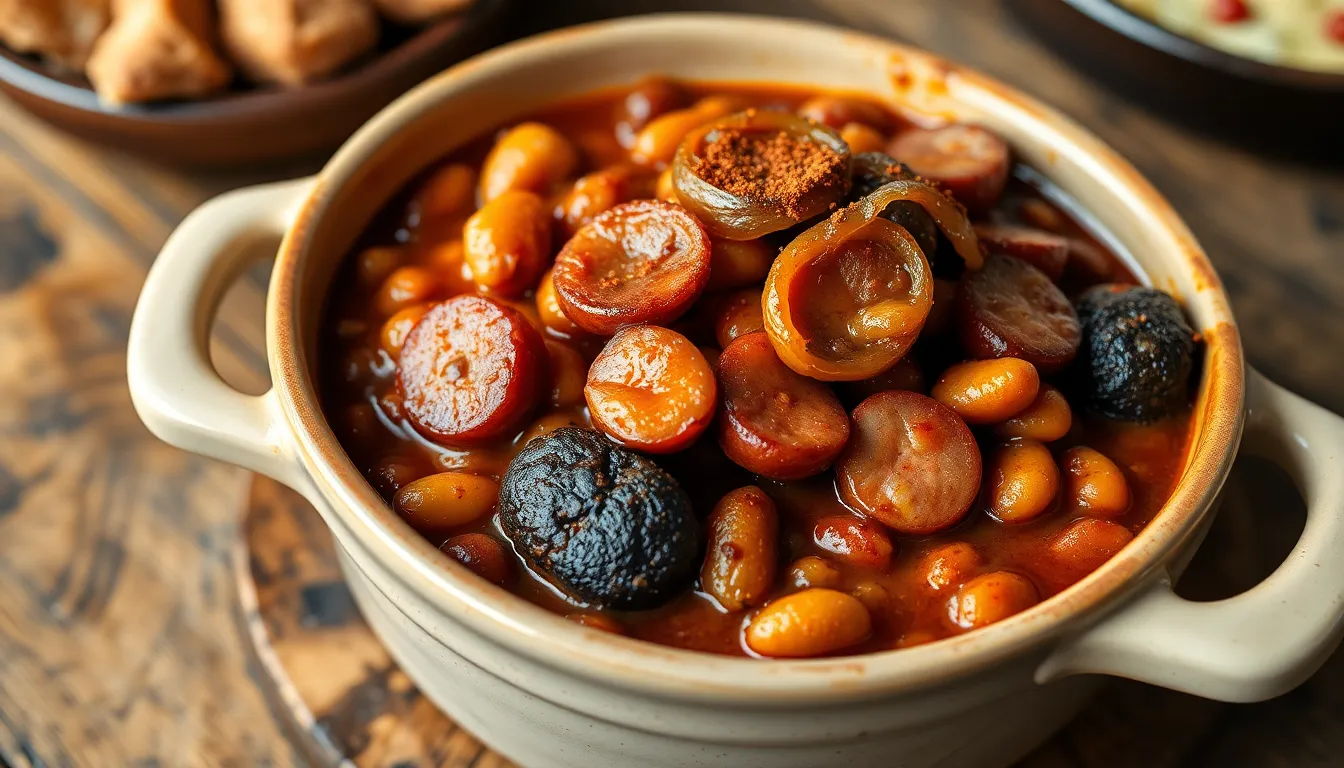
We’re taking your BBQ sauce game to the next level with this hearty dish that combines smoky sausage, tender beans, and tangy barbecue sauce. This comfort food favorite delivers restaurant-quality flavors straight from your kitchen.
Bean Variety Selection Guide
Navy beans offer the perfect foundation for this dish with their soft texture and mild flavor that absorbs BBQ sauce beautifully. We recommend combining multiple bean varieties to create depth and visual appeal in your casserole.
Kidney beans add firmness and a slightly sweet taste while contributing beautiful color and substantial texture. Their robust structure holds up well during the baking process without becoming mushy.
Pinto beans bring a creamy consistency and earthy flavor that complements smoky elements perfectly. These beans create a rich base that balances the tangy BBQ sauce with their natural creaminess.
Combining different beans creates complexity in both flavor and texture, making each bite more interesting than single-variety preparations.
Smoky Flavor Enhancement Tips
Smoked sausage serves as the primary protein and smoke source in this dish, infusing every bean with rich, savory flavor. We suggest slicing the sausage into rounds before mixing it with the beans for even distribution.
Smoked paprika adds an extra layer of smokiness without overwhelming the dish when used sparingly. A teaspoon or two blends seamlessly with your BBQ sauce to intensify the smoky profile.
Caramelized onions provide a sweet undertone that balances the tangy BBQ sauce while adding depth to the overall flavor profile. Cook them slowly until golden brown before incorporating into your bean mixture.
Low and slow cooking allows all the smoke and BBQ sauce flavors to meld completely, creating a harmonious blend that penetrates every ingredient.
Make-Ahead Preparation Strategies
Preparing the beans and sausage mixture a day ahead allows flavors to develop and meld in the refrigerator overnight. We find this technique actually improves the final dish’s taste complexity.
Day-ahead assembly means you’ll simply need to bake the dish just before serving to warm it through and achieve that perfect caramelized top. This approach saves valuable time during busy weeknight dinners.
Slow cooker preparation offers another convenient option where you can combine beans, sausage, and BBQ sauce on low heat for several hours. This method creates incredibly tender beans while allowing flavors to blend beautifully throughout the cooking process.
Refrigerated assembled dishes should be brought to room temperature for about 30 minutes before baking to ensure even heating throughout.
BBQ Pizza With Grilled Chicken and Red Onion
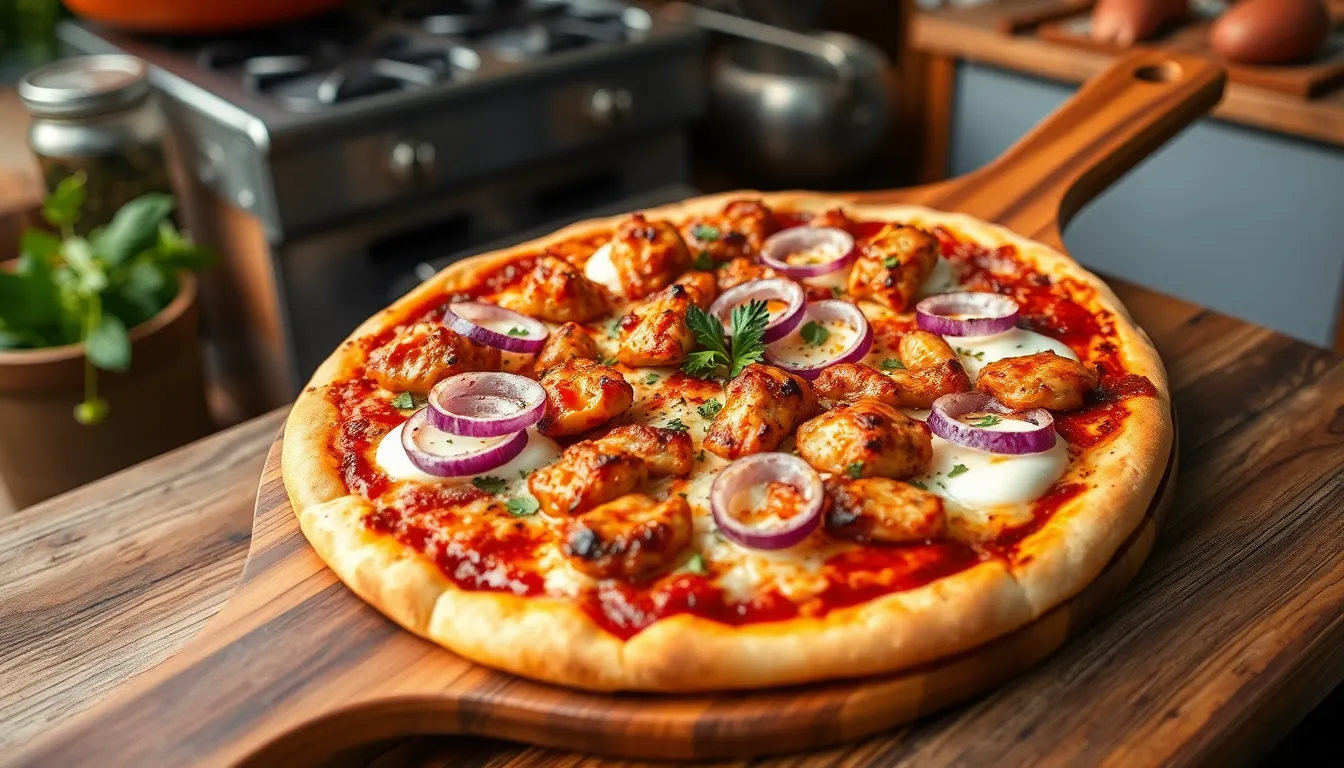
We’re taking our BBQ sauce journey to the pizza area, where smoky flavors meet Italian tradition. This combination creates a unique dinner experience that brings together the best of both culinary worlds.
Homemade vs Store-Bought Dough Options
Homemade dough gives us complete control over texture and flavor, allowing customization that creates a fresher and more flavorful pizza base. We can adjust the thickness, add herbs, or incorporate whole wheat flour to match our preferences perfectly. The process requires time for preparation and rising, but the results often justify the extra effort.
Store-bought dough offers convenience and consistent results that work exceptionally well for quick weeknight BBQ pizzas. Many grocery stores provide pre-made pizza dough or crusts that save preparation time without sacrificing quality. We find this option particularly useful when we want to focus our energy on perfecting the toppings rather than the base.
Our choice between homemade and store-bought dough eventually depends on balancing convenience with culinary control. Both options create excellent foundations for BBQ chicken pizza when handled properly.
Sauce Distribution for Balanced Flavor
Even sauce distribution is crucial for achieving balanced flavor across every bite of our BBQ pizza. We should spread the BBQ sauce generously as the base layer, ensuring it reaches the edges without creating puddles that could make the crust soggy.
Sufficient coverage means using enough sauce to taste the BBQ flavor in each slice while avoiding oversaturation. The sauce shouldn’t be overwhelmed by other toppings, as it provides the signature BBQ taste that defines this pizza style.
Enhanced sauce mixtures can elevate our pizza by combining BBQ sauce with complementary ingredients like olive oil or seasoning. This technique improves both flavor depth and texture distribution across the pizza surface.
Cheese Selection for BBQ Compatibility
Mozzarella cheese remains our top choice due to its excellent melting qualities and mild flavor that complements BBQ sauce without competing for attention. Its creamy texture creates the perfect backdrop for smoky BBQ flavors.
Alternative cheese options that pair beautifully with BBQ sauce include smoked gouda, cheddar, and provolone. These varieties add depth through their distinct flavor profiles, creating sharp or smoky contrasts to the sweetness and tanginess of BBQ sauce.
Blended cheese combinations offer the best of both worlds by mixing mozzarella’s superior melting properties with sharper or smoked cheeses. We recommend using mozzarella as the base and adding smaller amounts of specialty cheeses to elevate the pizza’s overall flavor profile while maintaining that essential creamy texture.
BBQ Stuffed Bell Peppers With Ground Turkey
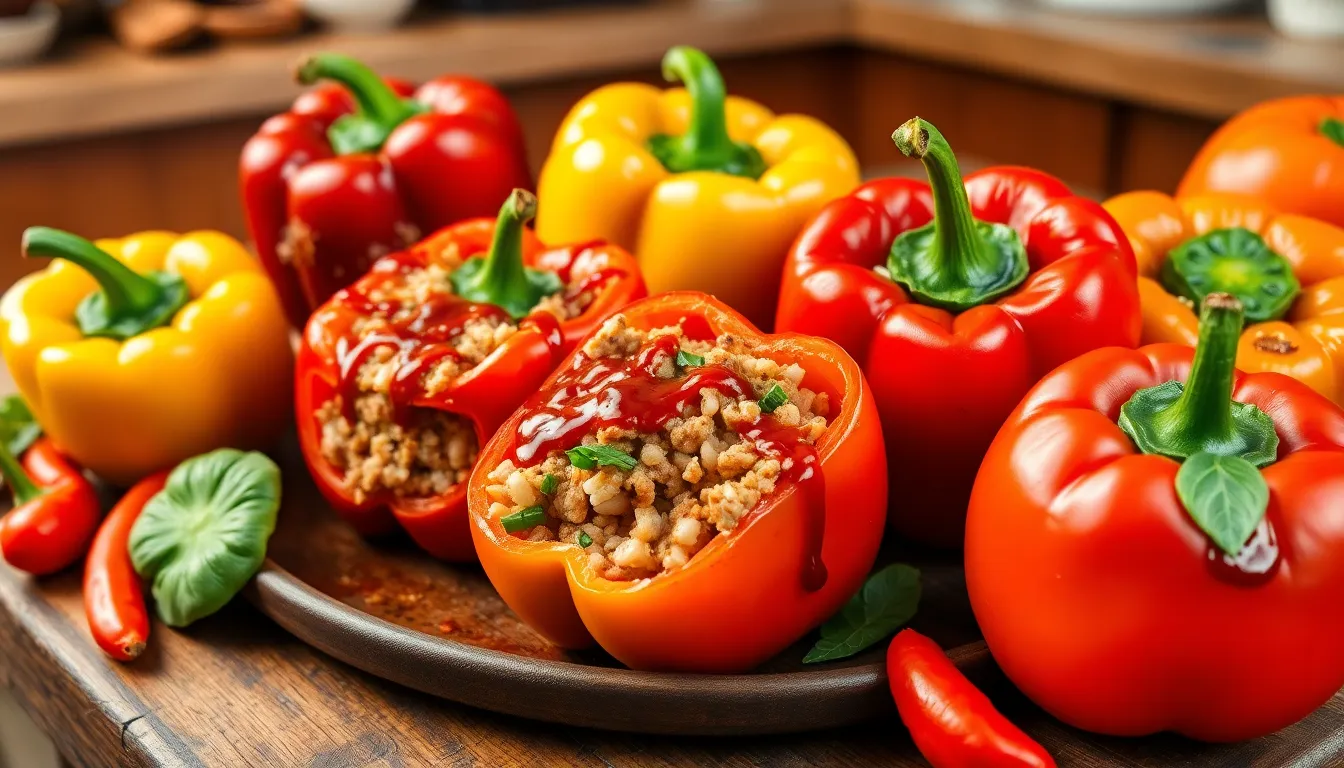
We’re bringing BBQ flavors into comfort food territory with these satisfying stuffed peppers that transform lean ground turkey into a smoky, savory dinner.
Pepper Preparation and Selection
Selecting medium to large bell peppers maximizes our filling capacity and creates the perfect vessel for our BBQ turkey mixture. Red, yellow, and orange varieties offer natural sweetness that complements BBQ sauce’s smoky tang better than green peppers.
Preparing the peppers requires careful attention to create sturdy containers for our filling. We slice off the tops cleanly, remove all seeds and white membranes thoroughly, and blanch them briefly in boiling water if we want extra tenderness before stuffing.
Rice and Seasoning Combinations
Choosing the right rice base gives our stuffed peppers ideal texture and substance. White rice provides classic comfort, brown rice adds nutty flavor and nutrition, while Minute® Ready to Serve rice offers ultimate convenience for busy weeknights.
Building our seasoning blend transforms plain rice into BBQ-worthy filling. Garlic powder, smoked paprika, cumin, black pepper, and onion powder create depth that pairs beautifully with BBQ sauce’s complex flavors.
Improving the mixture with sautéed onions, minced garlic, and diced vegetables adds texture and nutrition to each bite. We integrate pulled pork seasoning blends or BBQ sauce marinades directly with our cooked rice for authentic smoky taste throughout.
Healthy BBQ Sauce Alternatives
Traditional BBQ sauces pack high amounts of sugar and preservatives that can derail healthy eating goals. Creating homemade versions lets us control ingredients while maintaining that tangy, smoky flavor we crave.
Natural sweeteners like honey, maple syrup, and date paste replace refined sugar effectively in our BBQ sauce recipes. We combine these with organic tomato paste, apple cider vinegar, smoked paprika, and fresh garlic for clean ingredient profiles.
Store-bought options now include low-sugar and reduced-sodium varieties that save time without sacrificing taste. Mustard-based and vinegar-based BBQ sauces reduce calories significantly while delivering bold, tangy flavors that enhance our ground turkey perfectly.
Using BBQ sauce in moderation with lean proteins like ground turkey creates balanced, nutritious meals that satisfy our comfort food cravings without excess calories.
BBQ Salmon With Maple Glaze
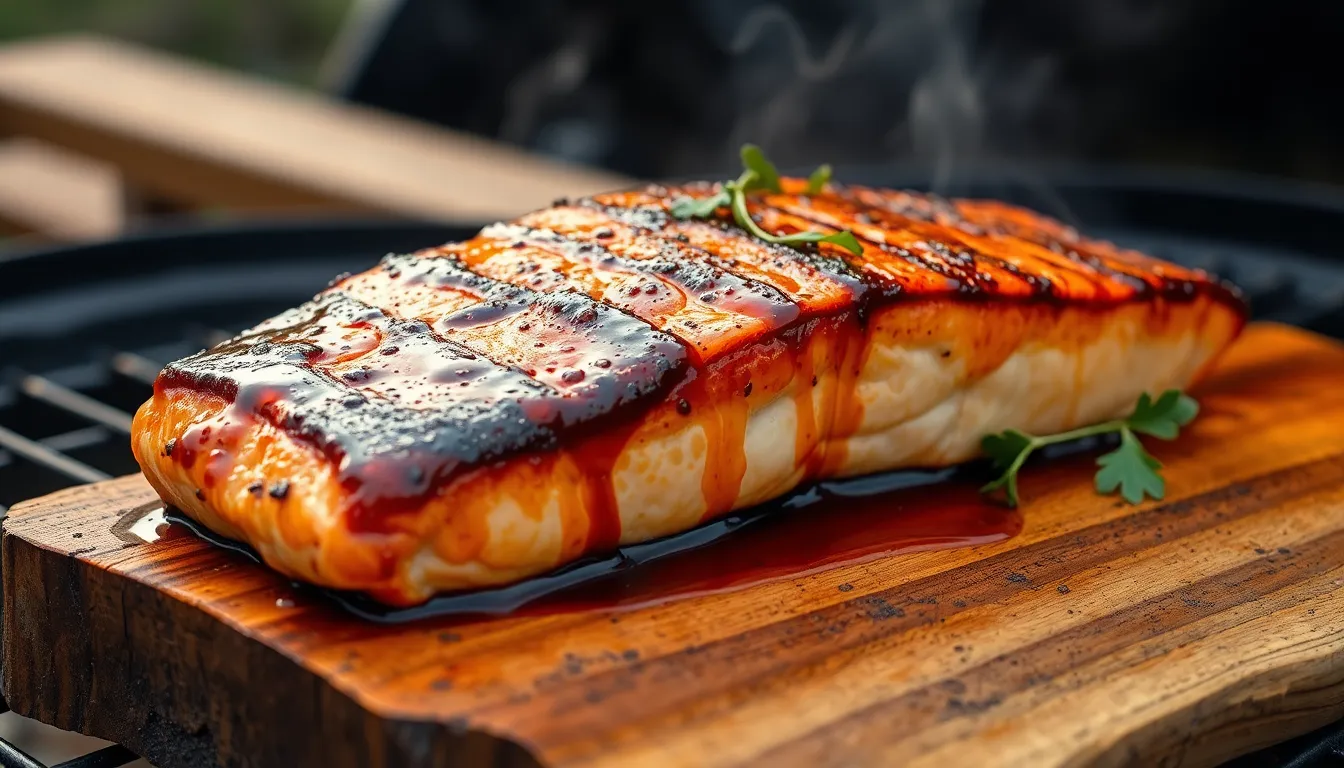
We’re elevating seafood with this elegant BBQ salmon that combines sweet maple syrup with smoky barbecue flavors. This sophisticated dish proves that BBQ sauce dinner ideas extend beautifully beyond traditional meat preparations.
Fish Selection for Grilling Success
Fresh, wild-caught salmon delivers the best flavor and texture for our BBQ maple glazed creation. We recommend choosing firm, thick cuts like center-cut fillets or salmon steaks that won’t fall apart during grilling.
Skin-on portions work exceptionally well since the skin helps hold the fish together while providing a deliciously crispy texture. Thick cuts ensure even cooking and prevent the delicate flesh from overcooking before the glaze caramelizes properly.
Wild salmon offers superior taste compared to farm-raised varieties, with its natural oils complementing the sweet and smoky BBQ maple combination perfectly. Look for fillets that are at least 1 inch thick to achieve the ideal balance of tender interior and beautifully glazed exterior.
Glaze Preparation and Application
Combining your favorite BBQ sauce with pure maple syrup creates the foundation for this irresistible glaze. We start with equal parts BBQ sauce and maple syrup, then customize with additions like minced garlic, smoked paprika, or a touch of Dijon mustard for complexity.
Brushing the glaze generously on both sides of the salmon before grilling ensures maximum flavor penetration. Multiple applications during cooking build beautiful layers of caramelization that make this dish restaurant-worthy.
Timing the glaze application prevents burning while maximizing flavor development. We apply the initial coating, then reapply every 3-4 minutes during grilling to create that perfect sweet and smoky crust.
Cedar Plank Grilling Techniques
Soaking cedar planks in water for at least 1 hour before grilling prevents burning while imparting subtle woodsy aromas to our BBQ salmon. This essential step transforms ordinary grilled fish into an aromatic, restaurant-quality experience.
Medium-high grill heat provides the ideal temperature for cedar plank cooking, allowing the salmon to cook evenly while the plank releases its signature smoky essence. We preheat our grill to ensure consistent cooking temperatures throughout the process.
Cooking time ranges from 12-15 minutes depending on thickness, with the salmon ready when it flakes easily with a fork. The cedar plank method keeps the fish incredibly moist while developing complex flavors that complement our maple BBQ glaze perfectly.
Closing the grill lid during cooking creates an oven-like environment that circulates the cedar smoke around the salmon, intensifying both the woodsy aroma and the caramelized glaze flavors.
Conclusion
These BBQ sauce dinner ideas prove that smoky barbecue flavors aren’t limited to weekend cookouts. From tender pulled pork to glazed salmon we’ve shown you how versatile BBQ sauce can be in transforming ordinary weeknight meals into something special.
The beauty lies in BBQ sauce’s ability to enhance everything from chicken and beef to seafood and vegetables. Whether you’re stuffing bell peppers glazing meatloaf or creating pizza masterpieces the right sauce brings depth and complexity to any dish.
We encourage you to experiment with different BBQ sauce styles and cooking techniques. Start with one recipe that excites you most then build your confidence from there. Your family dinners will never be boring again with these flavorful options in your cooking repertoire.
Frequently Asked Questions
What makes BBQ sauce versatile for weeknight dinners?
BBQ sauce works beyond traditional grilling through various cooking methods like braising, marinating, and stir-frying. It adds smoky, tangy flavors to dishes without needing a smoker. You can use it as a glaze, marinade, or finishing sauce to transform simple ingredients into flavorful meals quickly and easily.
How do I make perfect BBQ pulled pork in a slow cooker?
Season and sear a pork shoulder, then cook it in your slow cooker with BBQ sauce and apple cider vinegar. Cook on low heat for optimal tenderness. Once done, shred the meat and mix it with cooking juices and additional BBQ sauce for maximum flavor.
Should I use homemade or store-bought BBQ sauce?
Both options work well. Homemade sauce allows you to create signature flavors and control ingredients, while premium store-bought brands offer convenience. Consider your time constraints and flavor preferences. You can also enhance store-bought sauces with personal touches like spices or vinegar.
What’s the best way to grill BBQ chicken thighs?
Marinate chicken thighs with BBQ sauce and acidic ingredients like apple cider vinegar for tenderness. Grill at 350°F to 400°F, using direct heat for searing, then indirect heat to finish. Monitor internal temperature and let the chicken rest before serving for juicy results.
How do I prevent BBQ glaze from burning on meatloaf?
Apply BBQ glaze during the final stages of cooking to achieve caramelization without burning. Start with a base layer, then add additional coats in the last 15-20 minutes. Monitor closely and adjust oven temperature if needed to prevent the sugars in the sauce from charring.
What’s the difference between dry rubs and wet BBQ sauces for ribs?
Dry rubs create a flavorful crust and penetrate the meat during cooking, while wet sauces add moisture and create a glossy finish. Dry rubs are applied before cooking, wet sauces during the final stages. Both enhance flavor differently – rubs for depth, sauces for surface flavor and appearance.
How long should I grill BBQ shrimp to avoid overcooking?
Grill shrimp for 2-3 minutes per side over medium-high heat. They’re done when they turn pink and opaque. Overcooking makes them rubbery, so watch closely. Use skewers for easier handling and even cooking, and brush with BBQ sauce during the final minute of grilling.
What’s the best bacon for wrapping chicken breasts?
Use thick-cut bacon for BBQ bacon-wrapped chicken. It provides better coverage, stays in place during cooking, and achieves the right crispiness without overcooking the chicken. Wrap systematically, overlapping slightly, and secure with toothpicks if needed for even cooking and presentation.
Which beans work best for BBQ baked beans?
Navy, kidney, and pinto beans create the best texture and flavor combination. Navy beans are creamy, kidney beans hold their shape well, and pinto beans add earthiness. Using a mix provides complexity. Canned beans work for convenience, while dried beans offer more control over texture.
Can I make BBQ pizza dough from scratch?
Yes, homemade dough offers better flavor control and texture customization. However, store-bought dough provides convenience without sacrificing much quality. For BBQ pizza, choose dough that can handle heavier toppings and won’t become soggy from the sauce. Both options work well with proper preparation.







